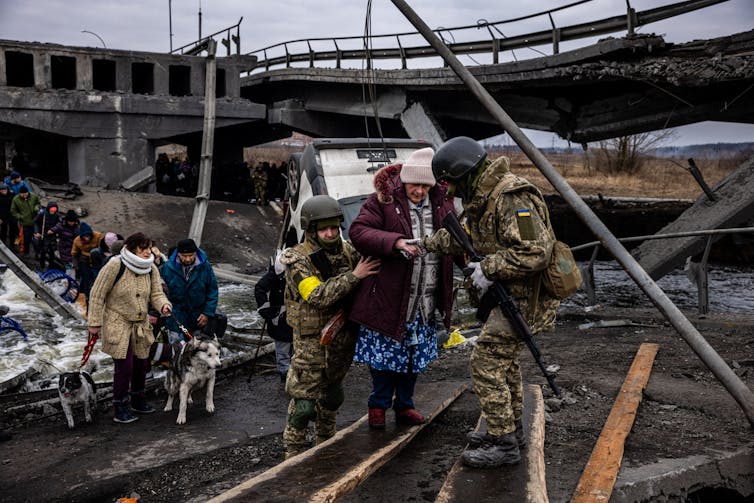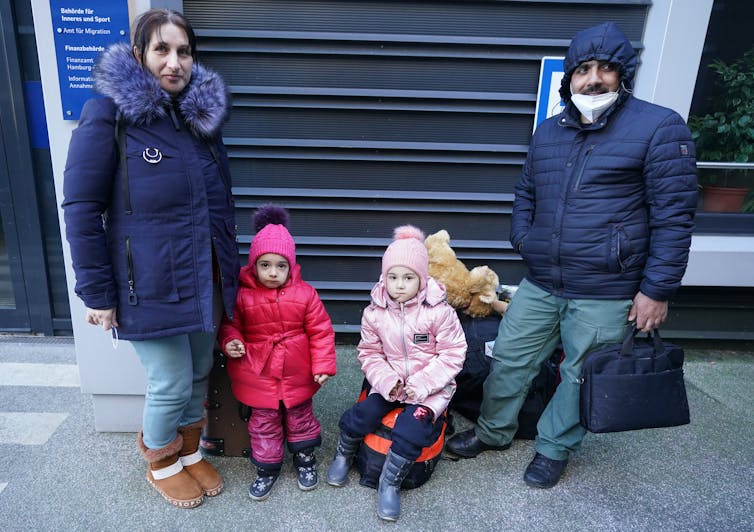More than 2 million Ukrainians – almost all women and children – have fled Ukraine since Russia invaded on Feb. 24, 2022. The sudden exodus of Ukrainian refugees is at a scale not seen in Europe since World War II.
The migration of Ukrainian refugees has prompted a swift international and regional response, including everything from celebrity online fundraising campaigns that have raised more than US$18 million to European countries opening their doors to Ukrainians.
But this momentum is unlikely to sustain itself. That’s in part because refugee assistance is chronically underfunded across the world, leaving forcibly displaced populations on the brink of starvation and without critical supplies.
As experts on forced migration and host communities, our research shows that in order to sustain a large humanitarian response, it’s important to balance the needs of both refugees and host communities with financial and policy support. This reduces refugees’ vulnerability and assists those who welcome them.

Understanding forced displacement from Ukraine
Russian military attacks have killed more than 400 Ukrainian civilians. There’s been widespread destruction of civilian homes and shelters and cases of Russians targeting civilians as they flee.
The United Nations Refugee Agency expects that the number of displaced Ukrainians will top 4 million by July 2022.
Approximately 59% of Ukrainian refugees are temporarily settling in record numbers in neighboring Poland. Humanitarian aid agencies and local citizens there are scrambling to provide food, clean water, shelter, transportation and money to arriving Ukrainians.
Around 40% of Ukrainians are expected to end up in Poland alone, with 410,000 in other neighboring countries, such as Hungary, Moldova, Romania and Slovakia. The remaining 1.8 million are expected to settle in other countries.
The U.N. and partner organizations have so far received only 7% of the US$1.1 billion they are asking countries to give to support Ukrainian refugees and host communities from March through May 2022.
Both ordinary citizens and corporations, like Netflix and AirBnB, have stepped forward with millions of dollars’ worth of donations to help the refugees.
But our research suggests that public attention to refugees is often fleeting, far shorter than the amount of time refugees typically remain away from their homes and need help.
Host communities tend to become tired of humanitarian responses as they continue on for years. Also, these responses are expensive, limiting refugees’ access to housing, cash and medical services, among other things, to live in their new countries.

A new kind of refugee response
The European Union agreed to a new plan on March 3 that allows Ukrainian refugees to legally stay in its 27-member countries for up to three years without first applying for asylum. This never-before-used policy will give Ukrainian refugees residence permits and access to work, health care and education.
The decision was not only unprecedented for the European Union, but it marked a major policy reversal for many of its members.
Poland was at the center of controversy in November 2021 after border police forcibly stopped Syrian, Yemeni and Iraqi migrants, resulting in several deaths. The human rights organization Council of Europe reported in May 2019 that Hungary was starving and caging refugees.
The suddenness of these governments’ turnabouts is unprecedented, when considering other refugee situations.
The Syrian war, for example, started in 2011. It wasn’t until 2014 that Turkey – a major destination for Syrian refugees – announced a policy that granted Syrians the legal right to work and get certain public services.
In Colombia, it took five years and several attempts to offer similar protections, including health care and education, to 1.8 million Venezuelan refugees.
The speed, unanimity and permissiveness of the EU’s new policy shows how governments can capitalize on political will to provide timely humanitarian solutions for refugees when they want to.
So far, the EU’s protections have not extended to all refugees, including African students and immigrants in Ukraine who have not been permitted or had difficulty crossing into other countries.

Supporting Refugee Host Communities
Based on our research on host communities’ responses to refugees, we have observed patterns in how attitudes change over time.
As we see now in Ukraine’s neighboring countries, regular citizens and civil society groups are stepping up to help refugees.
But this might change as large aid organizations settle in host communities and take over those roles.
We have observed, particularly when refugees live in camps, that large movements of people can result in environmental degradation caused by trash buildup, or when refugees cut down trees for firewood in places like Greece.
While refugees bring positive economic impacts to host communities in the long term, we have also observed that their arrival results in competition over low-wage jobs with local people.
People often connect long-term refugee stays with more crime, even though data shows otherwise.
Our interviews with host community members, aid workers and government representatives in Greece, Colombia and South Africa from 2017 to the present found that people began to feel that their towns were unrecognizable after hosting refugees and large aid operations for a few years.
People also told us that they did not know how to process the trauma of witnessing human suffering.
As scholars of forced migration, we believe the European citizens who see their towns turn into transit or host communities for Ukrainian refugees will begin to long for a time before the conflict, as we have heard in other host communities.
While it is not yet clear what the practical stresses on European host communities will be, the disruption to their towns and cities will likely wear down local residents. We have found that even in big towns and cities of more than 1 million people, locals observe the presence of refugees.
As this happens, our research suggests that a few steps focused on transparency would be helpful for maintaining long-term social stability.
Colombia, for example, hosts routine town halls across migration hot spots, where they explain migration policies and trends to communities.
This also means governments should continue to invest in host communities’ infrastructure. If there is an influx of refugees, governments can make sure that local sewage systems can accommodate more people. They can also give more money to hospitals to match larger populations’ needs.
Practices like these help host communities have a say in the future of their towns and feel confident about their growth. They also prevent the spread of rumors that can lead to anti-immigrant sentiments.
Ukrainian refugees may not be able to return home for years. Measures like the EU’s new policy give Ukrainians safe places to wait out the war and become self-sufficient during their stay.
[Get The Conversation’s most important politics headlines, in our Politics Weekly newsletter.]
This research is funded by grant number N000141912624 by the Office of Naval Research through the Minerva Research Initiative; none of the views reported in the study are those of the funding organization.
This research is funded by grant number N000141912624 by the Office of Naval Research through the Minerva Research Initiative; none of the views reported in the study are those of the funding organization.
This article was originally published on The Conversation. Read the original article.







